Scientists analysed venom samples from all five groups of centipedes and found a surprisingly vast difference between them.
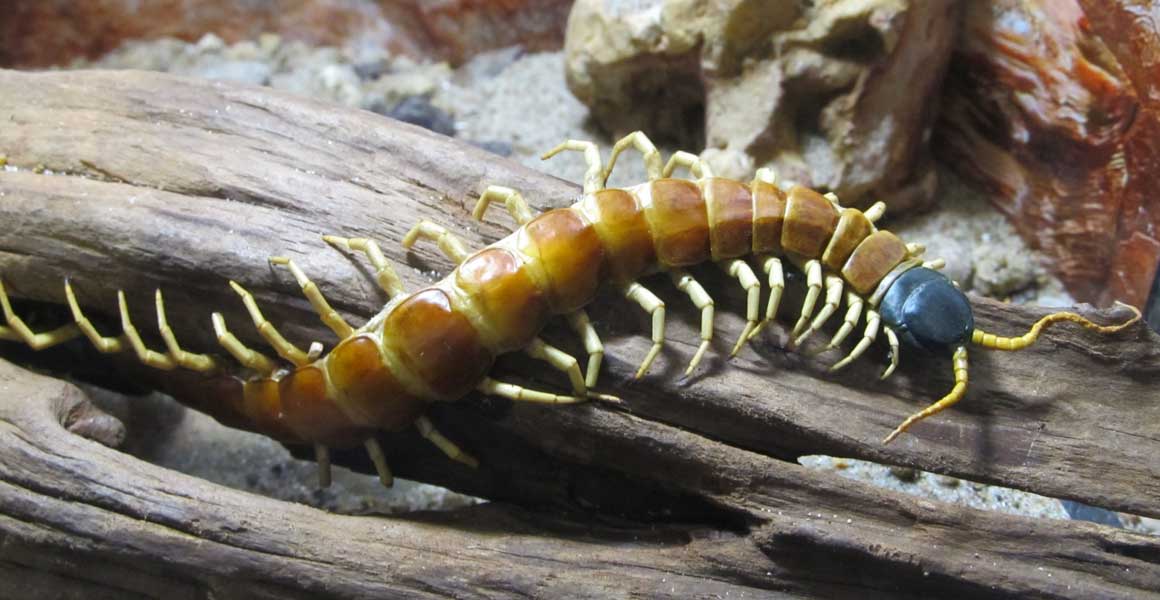
More than 3,100 species of centipedes have been described worldwide © Jean Beaufort/Public domain (CC0 1.0)
There are five different orders of centipedes, but venom from only one order, Scolopendromorpha, has really been studied.
Scolopendromorph centipedes, which include larger tropical species, are colourful invertebrates that are interesting to look at. Because of their larger size, they are easier to study than smaller-bodied species as they yield more venom.
The other four orders are house centipedes (Scutigeromorpha), stone centipedes (Lithobiomorpha), earth centipedes (Geophilomorpha) and two known as Craterostigmomorpha, which are only found in New Zealand and Tasmania. All four orders are arguably less charismatic and have mostly been overlooked in venom research as they are smaller and therefore more difficult to handle.
This means that research on centipede venom has been biased. Some scientists have even started regarding discoveries on scolopendromorphs as representing general insights into centipedes overall. This, as it turns out, has been a mistake.
Dr Ronald Jenner, a Museum expert on venom, says, 'Centipedes are one of the oldest venomous groups - they have been around for more than 400 million years.
'But all five groups are very different from one another and we cannot generalise.'
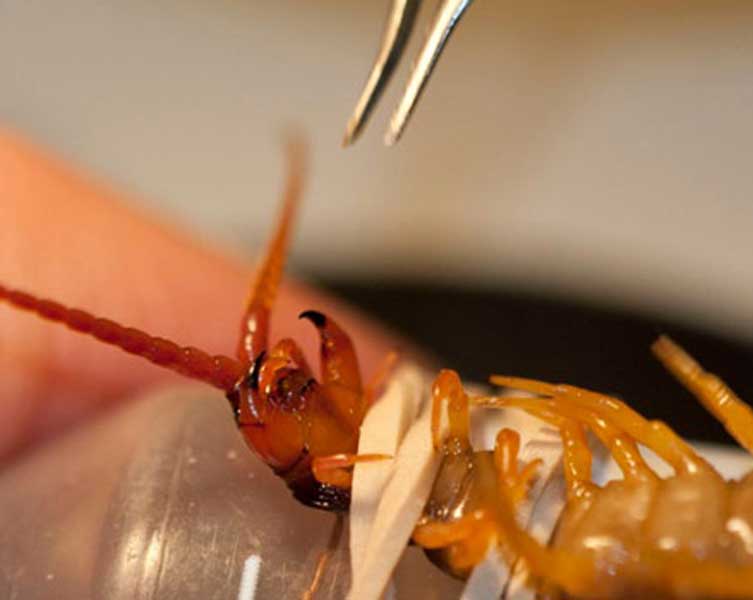
Ronald milking a centipede by stimulating the venom fangs with a pair of electrical forceps © Björn Marcus Von Reumont
What is venom made of?
Venoms may look the same, but they contain an assortment of chemicals.
These chemicals are made up of bioactive components, including proteins and peptides (small proteins), the two most important ingredients in venom. Other components are a mixture of salts and organic compounds such as amino acids, lipids and amines.
The bioactive components have a toxic effect on the body of an envenomed victim, which is why they are referred to as toxins.
These toxins come together to form thousands of different types of venoms found in the animal kingdom, and are used primarily for defence and predation.
How did centipede venom evolve?
Proteins - one of the main ingredients in venom toxins - are responsible for everyday housekeeping roles within the body, such as blood clotting and defence against microorganisms.
Their functions are so important that they have mostly remained unchanged over evolutionary time.
Some proteins, however, have evolved into venom toxins. This process is called weaponising and can occur in different ways.
One way is when a protein changes its preference for its target. For example, antimicrobial peptides (agents that kill harmful microbes) can evolve an attraction for ion channels (proteins involved in the generation and transmission of nerve impulses). When expressed in venom, these modified peptides can function as neurotoxins, helping a venomous animal to subdue its prey.
The second instance of weaponising is when a protein remains unchanged but is present in venom in a high concentration. The high dosage has a toxic effect when injected by disrupting the finely balanced physiology of the victim.
'Anything can be a weapon if increased in concentration,' says Ronald. 'A human can be hit on the head with a broom and be perfectly fine. But if they were to be repeatedly hit with a greater force, they can die.'
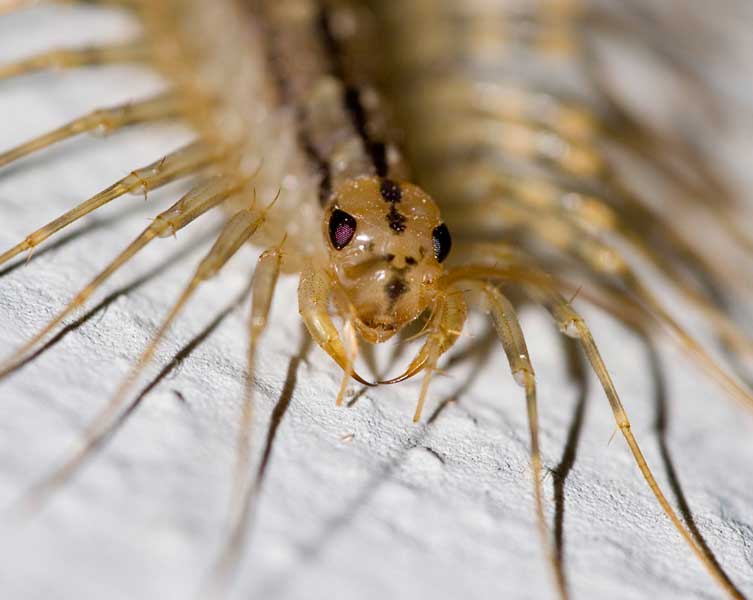
House centipedes like to live in association with humans, particularly in cool, moist areas such as the basement or under a damp towel on the bathroom floor © Stefano Moscardini/Flickr (CC BY-ND 2.0)
Why is studying venom important?
'Exploring venoms is very exciting,' says Ronald. 'They are nature's ultimate weapon, and studying them allows us to understand venomous animals better, as well as point to possible ways in which venoms can be exploited, for instance to tackle human diseases.'
The purpose of venom is primarily for defence or to catch prey. Although venoms are locally delivered by stings and bites, their effects are usually widespread as they target systems distributed throughout the body, such as the nervous system.
By studying how venom toxins affect the body, scientists can both learn new things about how bodies work and develop venom-based medicine. They could also help in producing new medicine for people who suffer from other medical conditions such as Parkinson's disease.
Animal venoms have already contributed to the development of successful pharmaceuticals for conditions such as chronic pain, diabetes and hypertension, and many more are being tested in clinical trials.
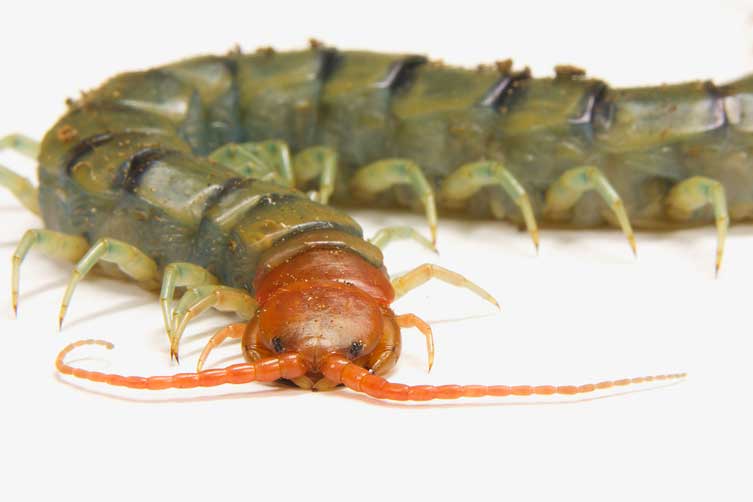
Many venom toxins are target-specific, and they often aim for the nervous system and the blood-vascular system © Eivind Undheim
The first-ever centipede venom evolutionary tree
Ronald wanted to gain a broader and more accurate understanding of centipede venoms.
In order to achieve that, he and two postdoctoral researchers, Björn von Reumont and Lahcen Campbell, teamed with Dr Eivind Undheim, a world-leading expert in centipede venom, and gathered samples from all five groups of centipedes.
They reconstructed how venom components have evolved across the evolutionary tree of centipedes and discovered that the ancestral centipede venom was made up of just four components. They think this simple cocktail was enough to paralyse and predigest their prey.
'This was a very simple weapon used to catch prey through paralysis,' says Ronald.
Strikingly, the team's results suggest that ancestral centipede venoms remained simple cocktails for roughly the first 50 million years of centipede evolution. It is only after the five orders had split from each other that they independently evolved much more complex venoms, each comprising a unique cocktail of toxins.
This is in contrast to expectations based upon previous research that showed that venoms in other groups, including venomous snakes, were already complex cocktails when they first evolved.
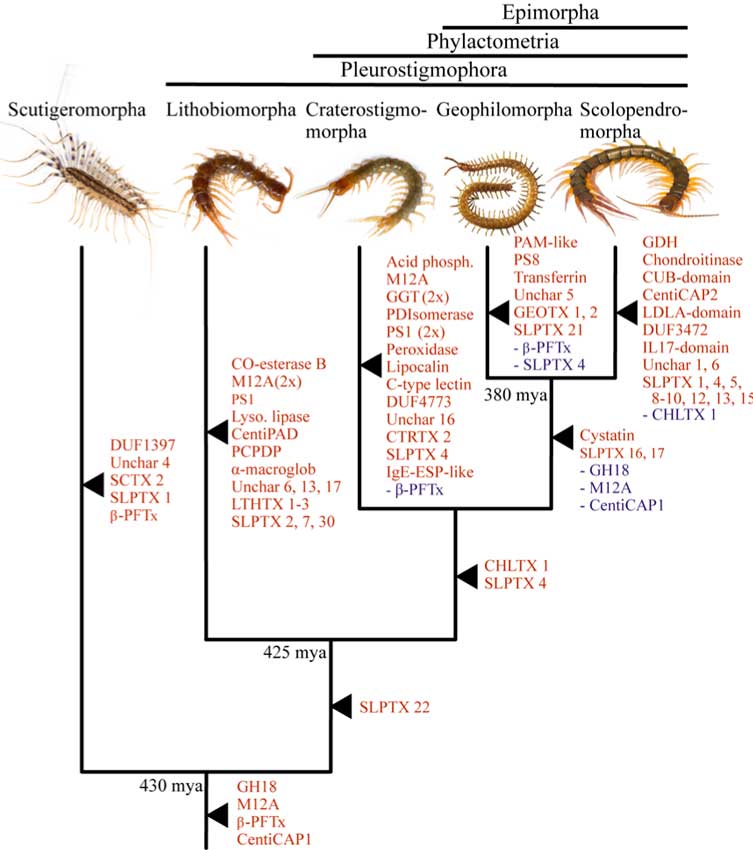
The evolutionary history of centipede venom composition. Red indicates where toxin families have been added to centipede venoms and blue indicates where they have been lost.
New findings in centipede venom
Ronald and his colleagues analysed the venoms of nine centipede species and discovered over 90 venom protein families between them. These families included enzymes, other proteins and peptides. Fourteen of these families had never been described from centipede venoms before.
The most complex venom was found in two Australasian scolopendromorph species, containing 47 and 48 toxin families.
This was six times as many families as the simplest venom, found in a house centipede with only eight families. The venoms of the other species contained between 12 and 28 families of proteins.
What's more, not a single component was present in the venoms of all five orders of centipedes. In fact, 67 toxin families were unique to single orders.
'The venoms were almost incomparable,' says Ronald. 'Therefore we cannot speak in general of centipede venom - there is no such thing.'

Ronald spent two weeks in New Zealand searching for an elusive species of craterostigmomorph centipedes. Other field locations include Scotland and Putney in London. Photo by Tammana Begum.
What does the future hold for this investigation?
The new study raises many interesting questions, and Ronald and Eivind are continuing research why and how venoms greatly diversified in the evolution of centipedes later rather than sooner. They are also trying to find out why they evolved into such different concoctions.
'This study looked at representatives of all the different groups of centipedes which has never been done before,' says Ronald. 'Future studies that will dig more deeply into this diversity will undoubtedly provide many more new insights into centipede venom biology and evolution.'
Read more
- The paper is published in Molecular Biology and Evolution
- Keep up to date on centipede research
- Tweet the world leading venom specialist

What on Earth?
Just how weird can the natural world be?
Don't miss a thing
Receive email updates about our news, science, exhibitions, events, products, services and fundraising activities. We may occasionally include third-party content from our corporate partners and other museums. We will not share your personal details with these third parties. You must be over the age of 13. Privacy notice.
Follow us on social media